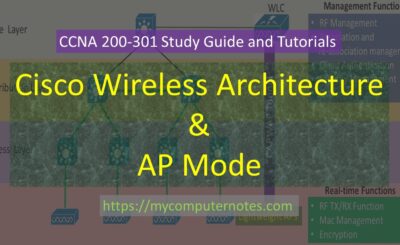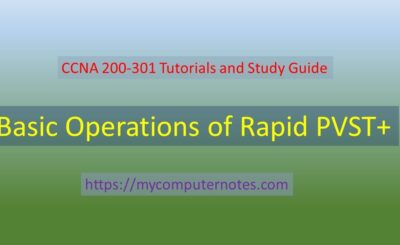In the previous section, we discussed the basic concept of spanning tree protocols and their working. In this section, we are going to discuss the different types of spanning tree protocols.
Different Types of Spanning Tree Protocols
The various types of spanning tree protocols are
- CST/STP – IEEE 802.1d
- PVST and PVST+
- RSTP – IEEE 802.1w
- Rapid PVST+
- MSTP IEEE 802.1s
IEEE 802.1d CST/STP
- It is the original STP developed by IEEE and as 802.1d.
- It was introduced by Radia Perlman in 1990,
- It is the first and the original spanning tree protocol to prevent loops in an Ethernet network.
- It is also named CST (Common Spanning Tree).
- 802.1d elects only one root bridge for the entire STP topology regardless of the number of VLANs.
- It has a very slow convergence and takes 32 seconds to converge.
Advantages
- 802.1d utilizes less memory and CPU usage.
Disadvantages
- It cannot provide efficient load-balancing.
- The process of convergence is very slow.
PVST and PVST+
- PVST stands for Per VLAN Spanning Tree.
- PVST is Cisco’s Proprietary implementation of spanning tree protocol.
- It provides a separate STP instance for each VLAN so that each VLAN can have its own root bridge and can operate independently from other VLANs.
- PVST uses the IEEE 802.1d STP protocol on each VLAN with a separate instance for each VLAN.
- PVST does not support interoperability with IEEE 802.1q devices, whereas PVST+ allows the Cisco device to interoperate with a device that is running a single spanning tree with IEEE 802.1q protocol.
- PVST+ is an advanced version of PVST that is capable of supporting the RApicd Spanning Tree Protocol.
- PVST+ provides faster convergence and also supports multiple spanning trees (MST).
Advantages
- Provides improved network performance with separate STP instances for each VLAN.
- Enhanced redundancy is maintained at the VLAN level. Failure on one VLAN does not impact the other VLANs.
- PVST + supports RSTP which provides faster convergence time.
Disadvantages
- PVST is a Cisco proprietary and is not compatible with devices from other vendors.
- Establishing and maintaining multiple STP instances can be complex and requires significant management efforts.
RSTP – IEEE 802.1w
- RSTP stands for Rapid Spanning Tree Protocol.
- It is developed by IEEE and is defined as IEEE 802.1w standard.
- RSTP provides a faster convergence time than CST.
Advantages
- RSTP has a faster convergence time of only 2 or 3 seconds as compared to traditional STP.
- RSTP can help to recover failed ports and unblock them faster than STP.
- RSTP uses a different loop prevention technique called the BPDU guard. This feature protects the network against loops caused by rogue or misconfigured switches.
- It allows for better utilization of the network resources by activating all available paths in a network.
Disadvantages
- RSTP is more complex. It is harder to configure and manage, particularly in larger networks.
- It is not compatible with traditional STP.
Rapid PVST+
- Rapid Per VLAN Spanning Tree Plus (Rapid PVST+) is an advanced version of the common Spanning Tree Protocol (STP) that provides faster convergence time for Layer 2 network loops.
- It is a Cisco proprietary protocol that runs on Cisco switches, and it supports per-VLAN spanning-tree instances.
Advantages
- Rapid PVST+ has a faster converge time of very few seconds if any changes are detected in the network topology, reducing the downtime experienced by end-users.
- It can support up to 5000 VLANs, making it suitable for even the largest networks.
- With Rapid PVST+, switch ports can be enabled more quickly, reducing the time and labor required to set up the network.
- It provides an additional layer of security by isolating the broadcast traffic within each VLAN.
- Rapid PVST+ allows for load balancing across multiple paths, leading to better utilization of available network resources.
Disadvantages
- Rapid PVST+ is a Cisco proprietary protocol that only works on Cisco equipment, limiting interoperability with equipment from other vendors
- It is a complex protocol, requiring specialized knowledge to implement and troubleshoot.
- Due to its complexity, Rapid PVST+ requires skilled personnel, leading to increased operational costs.
- Rapid PVST+ is not backward compatible with older versions of PVST, making upgrades difficult and time-consuming.
MSTP IEEE 802.1s
- Multiple STP (Spanning Tree Protocol) is a method of configuring multiple instances of STP on a network.
- This allows for better load balancing, redundancy, and improved network performance.
- Multiple STP can be achieved using various protocols, including MSTP, RSTP, and PVST+.
Advantages
- Multiple STP allows for multiple paths to be active at once, leading to better network performance.
- MSTP can distribute traffic across multiple links, balancing the load and preventing network congestion.
- It provides redundancy, ensuring that the network remains operational even if a link or switch fails.
- It has a faster convergence time
Disadvantages
- Configuring multiple STP protocols is more complex than configuring traditional STP and requires specialized knowledge.
- Implementing multiple STP protocols requires supporting hardware and software, leading to increased costs.
- MSTP may not be interoperable with hardware and software from other vendors, limiting flexibility.
- The complexity of MSTP protocols increases the risk of misconfiguration, leading to network issues.
| ← Prev | Next → | |
| How Spanning Tree Protocol Works | Basic Operations of Rapid PVST+ Protocol |






